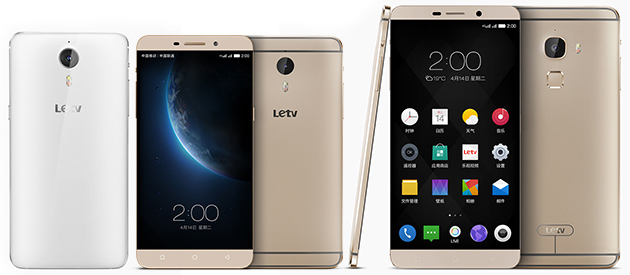Following the Nokia N1, the new Chromebook and the new MacBook, who knew the world's first USB Type-C smartphones would come from a Chinese company? The brand in question is LeTV, who has today unveiled three new Android 5.0 "Superphones" that feature the reversible socket. The flagship aluminum Le Max (pictured above) is all about the absolute top specs: a 6.33-inch Quad HD display, a Snapdragon 810 chip (2GHz, octa-core, 64-bit), 4GB of LPDDR4 RAM, a whopping 64GB or 128GB of internal storage, a 21-megapixel f/2.0 camera (with Sony's new IMX230 sensor, plus optical stabilization and dual-tone flash) and a bright UltraPixel selfie imager.
The Le Max also boasts an ESS Hi-Fi chip (with AKG's audio tuning), a one-touch fingerprint reader on the back, infrared remote, a 3,500 mAh battery, dual LTE SIM support and WirelessHD display link. But what really caught our attention were the design cues taken from the iPhone 6 Plus (especially the plastic bands), Huawei's Mate 7 (both front and back sides) and HTC's One Max. The result doesn't look too bad, actually.

The smaller Le 1 Pro (pictured middle) is essentially a resized version of the Le Max, except for its smaller 5.5-inch screen, a lesser 13-megapixel main imager (still with optical stabilization), a smaller 3,000 mAh battery and storage options of just 32GB or 64GB. The fingerprint reader and WirelessHD are also gone here. As for appearance, the phone looks like a crossover between the iPhone 6 Plus, the Huawei Mate 7, the Meizu MX4 Pro and HTC's One Mini.
As for the affordable Le 1 (pictured left), it feels more like a bog-standard phone but still with great value. You get a 5.5-inch 1080p display, MediaTek Helio X10 (2.2GHz, octa-core, 64-bit), 3GB of LPDDR3 RAM and storage options of 16GB, 32GB plus 64GB. The main camera and battery are practically identical to that of the Le 1 Pro, though the front-facing camera has a 5-megapixel sensor with wider-angle optics. Also, there's no Hi-Fi chip to be found here. Understandably, the Le 1 ditched the more expensive unibody design and went with the plastic-on-aluminum-frame approach. Pardon the echo, but the back does look almost the same as the MX4 Pro; which isn't a bad thing.

For a company who's never made phones before, the specs here are surprisingly ambitious, which is just as well given the aggressive marketing campaign ahead of this event. And as with most Chinese smartphones these days, LeTV doesn't seem to plan on making huge profits off these devices. After all, this company's core business relies on video streaming and production, so it's more than happy to sell phones and TVs at low prices to build up its audience. Xiaomi's been pulling a similar strategy with its cheap TVs and set-top boxes, but without its very own video production house, it's an uphill battle against LeTV. Its run-in with the broadcast authorities back in late 2012 didn't help, either.
The Le 1 starts from just 1,499 yuan (about $240), whereas the Le 1 Pro starts from 2,499 yuan (about $400), while the Le Max remains a mystery but promises to be of very good value. In fact, the company claims that it'll be crowdsourcing a price for its flagship device, which is a clever marketing tactic that should worry local competitors such as Xiaomi and Huawei's Honor. If you live in China, you can pre-register for one of the 200 Le 1 engineering samples at 10am tomorrow local time; or you can wait for the pre-registration for the first 200,000 mass-production Le 1 and Le 1 Pro, which will be open at 10am on May 5th.


Inga kommentarer:
Skicka en kommentar